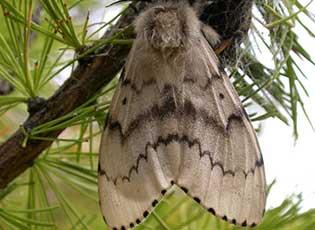Lymantria dispar asiatica Vnukovskij, Lymantria dispar japonica (Motschulsky), Lymantria albescens Hori and Umeno, Lymantria umbrosa (Butler), and Lymantria postalba Inoue (Djoumad et al. 2020)
Flighted Spongy Moth Complex (FSMC); formerly known as Asian gypsy moth (AGM) (APHIS 2022)
L. asiatica is native to temperate Asia east of the Ural Mountains; L. d. japonica, L. albescens, L. umbrosa, and L. postalba are native to Japan (Pogue and Schaefer 2007)
First discovered in the Pacific Northwest in the 1991 (Islam et al. 2015)
From infested cargo in ships (Srivastava et al. 2020)
It is a voracious pest of trees that poses a major threat to forest habitats in North America (Srivastava et al. 2020)
Not currently established. Eradicated in North Carolina and Washington.

Asian gypsy moth, female in Mongolia
Photo by John Ghent
Distribution / Maps / Survey Status
Videos
Selected Resources
The section below contains highly relevant resources for this species, organized by source.
Council or Task Force
Partnership
Federal Government
International Government
State and Local Government
APHIS. 2022. APHIS Announces New Common Names for Regulated Lymantria Moths. USDA, Animal Plant Health and Inspection Service.
Djoumad, A., A. Nisole, D. Stewart, et al. 2020. Reassessment of the status of Lymantria albescens and Lymantria postalba (Lepidoptera: Erebidae: Lymantriinae) as distinct ‘Asian gypsy moth’ species, using both mitochondrial and nuclear sequence data. Systematic Entomology 45(2): 493-504.
Islam, M.S., N.B. Barr, W.E. Braswell, et al. 2015. A multiplex real-time PCR assay for screening gypsy moths (Lepidoptera: Erebidae) in the United States for evidence of an Asian genotype. Journal of Economic Entomology 108(5):2450-2457.
Pogue, M., and P.W. Schaefer. 2007. A review of selected species of Lymantria Hübner (1819) (Lepidoptera: Noctuidae: Lymantriinae) from subtropical and temperate regions of Asia, including the descriptions of three new species, some potentially invasive to North America. USDA Forest Service, Forest Health Technology Enterprise Team. FHTET 2006-07.
Srivastava, V., V.C. Griess, and M.A. Keena. 2020. Assessing the potential distribution of Asian gypsy moth in Canada: A comparison of two methodological approaches. Scientific Reports 10:22.
